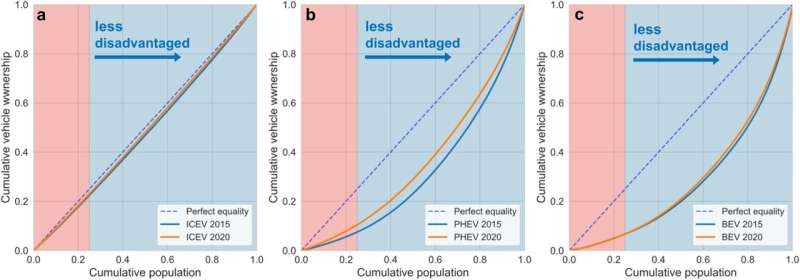This article has been reviewed according to Science X's editorial process and policies. Editors have highlighted the following attributes while ensuring the content's credibility:
fact-checked
peer-reviewed publication
trusted source
proofread
Electric vehicles improve air quality for everyone but have less impact in more polluted areas, study finds

Although electric vehicle ownership is higher in wealthier neighborhoods than in disadvantaged ones, EVs improve air quality in all communities, a UCLA study found.
But that's not the whole story. The traffic corridors that run through disadvantaged areas to spread those clean-air benefits remain a source of heavy pollution from gas-powered vehicles.
The study determined that widespread EV travel meant disadvantaged communities experienced 40% more pollution-reduction than other areas, but that was a large percentage of a small number. Meanwhile, low-income neighborhoods still faced significantly higher pollution levels than other communities, because of the higher volume of all vehicle trips in their vicinity. The paper published Dec. 12 in the journal Nature Communications.
"Because EVs travel all over, the benefits from reduced tailpipe emissions get shared across communities," said senior author of the study and air quality researcher Yifang Zhu, a professor in the UCLA Fielding School of Public Health and the UCLA Institute of the Environment and Sustainability. "That's encouraging, but there's still a gap in who gets clean air, and it's a big gap."
Possible solutions
The study, which also included authors from the UCLA Samueli School of Engineering, recommended policies offering more financial incentives for lower-income households to purchase zero-emission and electric vehicles, such as battery-electric, plug-in hybrid, and hydrogen fuel-cell vehicles. The researchers also strongly recommended that the state require medium- and heavy-duty vehicles—such as shipping and delivery trucks—to transition to zero-emission, since larger vehicles emit more pollution than smaller ones.
"Drivers in disadvantaged communities and lower-income communities don't own as many zero-emission vehicles as those in more affluent areas, and they live near transit arteries full of vehicles that still produce massive amounts of pollution," Zhu said. "To make a transition equitable and healthy, we need to encourage EV adoption across the board, we need to clean up the heavy fleet, we need to address brake and tire wear particles, and we need to include disadvantaged communities in discussions about the transition."
Parts of the study contributed to the LA100 Equity Strategies report outlining equitable pathways for the Los Angeles Department of Water and Power to reach 100% renewable electricity by 2035. The study also adds to a long-term project to work with disadvantaged communities to increase electric vehicle adoption.
The research involved creating a mobility simulation of Los Angeles County's 10 million people, layering information like census data on demographics, housing types and commutes, mixed with local traffic models and new survey data on vehicle use, like charging habits, interest in buying an EV and optimal locations for chargers.
The simulation projected how EV adoption would affect air quality and equity in 2035, when California will require all new passenger vehicles to be zero-emission. The researchers especially focused on making cleaner vehicles equitably accessible to everyone, said the study's co-author, UCLA engineering professor Jiaqi Ma, who researches mobility and developed the simulation in collaboration with Yueshuai He and others at the UCLA Mobility Lab.
"With this model, we can generate a good representation into the future of how policies will change people's action or see where charging stations will be useful," said Ma, an associate professor at the UCLA Samueli School of Engineering, director of a new U.S Department of Transportation-funded mobility center and associate director of the UCLA Institute of Transportation Studies.
"If a policymaker wanted to see how five alternative electric-vehicle policies would affect local residents in multi-unit dwellings, we can use the simulation to see that," Ma said. "We can project when and where they would want to charge their vehicles. When we talk about equity, it's not just qualitative but quantitative. We aim to share evidence to provide to policymakers so they can make equity-informed decisions."
Involving the community
The researchers found that EV ownership was much lower among nonwhite populations and disadvantaged neighborhoods, than in more affluent, white communities, noted lead author Qiao Yu, a graduate student studying how to transition to a carbon-free future.
For example, as of 2020, about 45% of L.A. County residents lived in disadvantaged communities but owned only 18% of the county's EVs. Nearly half of the county's EVs (45%) were owned by the roughly one-quarter (26%) of people identifying as white. Among the Hispanic population, the numbers were reversed: despite representing 48% of the county, they owned only 26% of EVs.
"We want to know why EV ownership is so much lower in disadvantaged communities, and find ways to change that," Yu said. "We're talking to community-based organizations to ask, what are your barriers to adopting EVs? Do you have access to charging stations? Do you know the pros and cons of EVs? Do you know about rebates? We want to make sure they're involved in deciding what policies would help them."
To make sure disadvantaged communities get a voice in the solution, Zhu said, the researchers' ongoing EV studies will continue to include community-based organizations that can answer those questions from first-person experience. "We need to better understand the barriers that aren't just financial," she said. "We want the communities to have a say."
More information: Qiao Yu et al, California's zero-emission vehicle adoption brings air quality benefits yet equity gaps persist, Nature Communications (2023). DOI: 10.1038/s41467-023-43309-9
Journal information: Nature Communications
Provided by University of California, Los Angeles





















